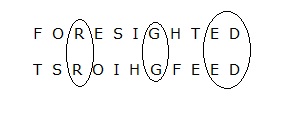Dear Readers, Take Free Reasoning Ability Sectional Test of 35 Questions as like in the real exam to analyze your preparation level. Our Sectional Test Questions are taken as per the latest exam pattern and so it will be really useful for you to crack the prelims exam lucratively. Students who are weak in Reasoning Ability should utilize this chance constructively to accomplish a successful profession in Banking Field.
[WpProQuiz 4444]Click Here for IBPS Clerk Prelims 2018 High-Quality Mocks
Direction (1-5): Study the following information carefully and answer the questions given below.
A, B, C, D, E, F, G, and H are sitting around a circular table. Some of them are facing outside and some of them are facing inside. Not more than two persons are facing same direction sit together.
F sits third to the left of H. D sits fourth to the right of G and both are facing opposite direction. Only two persons sit between F and C. Immediate neighbours of H are facing opposite direction. G is not an immediate neighbour of H. A sits second to the left of B, who does not sit opposite to H. F and G are facing same direction. A does not face inside.
1) How many persons sit between E and B?(When counted clockwise direction from E)
a) None
b) One
c) Two
d) Three
e) None of these
2) What is the position of A with respect to C?
a) Second to the right
b) Third to the right
c) Third to the left
d) Second to the left
e) None of these
3) Who among them are immediate neighbours of D?
a) B, E
b) H, F
c) B, H
d) Three
e) None of these
4) Which of the following statements is/are true?
I. B and A are immediate neighbours of F.
II. G sits immediate left of A.
III. E faces outside
a) Only I
b) Only II
c) Only III
d) Only I & II
e) All of the above
5) Four of the following are alike in a certain way so form a group which of the following does not belong to the group?
a) B
b) G
c) D
d) E
e) H
Direction (6-10): Study the following information carefully and answer the questions given below.
I, J, K, L, M, N, O, and P live in a nine storey building and one floor is vacant. Ground floor is numbered 1 and the topmost floor is numbered 9.
I lives second position from the top. N lives an even numbered floor but not on the floor number 4. Only two Persons live between M and J and both are live in odd numbered floor. One of the even numbered floor is vacant. P lives third position from the bottom. J lives one of the floors above the vacant floor. L lives three floors above from K. J and K are lives in adjacent floors.K lives an immediately above J
6) O lives in which of the following floor?
a) 3
b) 5
c) 7
d) 9
e) None of these
7) How many persons live between P and K?
a) None
b) One
c) Two
d) Three
e) None of these
8) Which of the following floor is vacant?
a) 2
b) 4
c) 6
d) 8
e) None of these
9) Which of the following statements is/are true?
I. P lives immediately below N
II. K lives in the seventh floor
III. O and I are lives in adjacent floors
a) Only I
b) Only II
c) Only III
d) Only I & II
e) All of the above
10) Four of the following are alike in a certain way so form a group which of the following does not belong to the group?
a) L
b) O
c) J
d) P
e) I
Directions (11-15): Study the given information and answer the questions:
When a word and number arrangement machine is given an input line of words and numbers, it arranges them following a particular rule. The following is an illustration of input and its rearrangement.
Input: Measure 57 small capital 62 47 effect goods 25 91
Step I: small Measure 57 capital 62 47 effect goods 91 25
Step II: small effect Measure 57 capital 47 goods 91 25 62
Step III: small effect goods measure 57 capital 47 25 62 91
Step IV: small effect goods capital measure 57 25 62 91 47
Step V: small effect goods capital measure 25 62 91 47 57
Step V is the last step of the above arrangement.
As per the rules followed in the above steps, find out in each of the following questions the appropriate step for the given input.
Input: 48 Account 54 62 fixed output starts 43 29 grown
11) Which element is exactly between ‘48 and ‘62’ in Step IV?
a) Fixed
b) 43
c) Account
d) Output
e) Both (b) and (d)
12) What is the difference between the element which is second from left end in Step I and the element which is second from the right end in Step V?
a) 20
b) 19
c) 18
d) 17
e) None of these
13) How many steps are required to complete the above arrangements?
a) 5
b) 6
c) 7
d) 8
e) None of these
14) In which step the elements “fixed account 48” found in the same order?
a) 2
b) 3
c) 4
d) 5
e) None of these
15) In step V, ‘grown’ is related to ‘48’ and ‘fixed’ is related to ‘54’. In the same way ‘Account’ is related to?
a) 62
b) 43
c) 29
d) Output
e) None of these
Direction (16-17): Study the following information carefully and answer the questions given below.
A person starts walk from point A towards east direction and walks a distance of 7 km to reach point B. Then he takes left turn and walks a distance of 4 km to reach point C. At that point he takes right turn and walks a distance of 3 km to reach point D. After that he takes right turn and walks a distance of 8 km to reach point E. Then he takes right turn and walks a distance of 4 km to reach point F.
16) What is the direction of point A with respect to point F?
a) Southeast
b) Southwest
c) Northeast
d) Northwest
e) None of these
17) What is the shortest distance between point F and the point A?
a) √54
b) 2√13
c) √56
d) 3√13
e) None of these
Direction (18-19): Study the following information carefully and answer the questions given below.
P, Q, R, S, T, U, V, and W are the family members related to each other.There are three married couples in the family. Q is married to R. P is sister of Q. W is the son of U and the nephew of Q. T is daughter of V. Q is mother in law of V who is not male.
18) How is S related to P?
a) Daughter
b) Son
c) Niece
d) Nephew
e) None of these
19) How is T related to R?
a) Son
b) Daughter
c) Granddaughter
d) Grandson
e) None of these
20) How many pairs of letters are there in the word “METICULOUS” which has as many letters between them in the word as in alphabetical series both forward and reverse direction?
a) None
b) One
c) Two
d) Three
e) More than three
Direction (21-25): Study the following information carefully and answer the questions given below.
Ten persons are sitting in two parallel rows. D, E, F, G, and H are sitting in south facing row and T, U, V, W, and X are sitting in north facing row. None of the persons sit together in alphabetical order. It means E is not adjacent to both F and D and vice versa.
- T sits third to the right X.
- H faces the one who sits immediate left of U.
- Only two persons sit between F and E.
- F faces the person who is an immediate neighbour of T.
21) Who among them are seated at extreme right ends?
a) H,E
b) X,F
c) V,H
d) F,V
e) None of these
22) Who among the following person faces the one who sits second to the left of V?
a) H
b) D
c) F
d) G
e) None of these
23) How many persons sit between U and W?
a) None
b) 1
c) 2
d) 3
e) None of these
24) What is the position of E with respect to F?
a) Immediate right
b) Immediate left
c) Third to the right
d) Third to the left
e) None of these
25) Four of the following are alike in a certain way so form a group which of the following does not belong to the group?
a) T
b) E
c) D
d) U
e) V
Direction (26-30): Study the following information carefully and answer the questions given below.
P, Q, R, S, T, U, and V are attended the seminar on sevendifferent days in a week. The week starts from Monday to Sunday. Each of them has different ages 24, 26, 28, 32, 34, 36, and 38. All the given information is not necessarily in the same order.
V attends the seminar on one of the day after Thursday. The youngest person attends the seminar on Tuesday. P attends the seminar immediately after U, whose age is 38 but not on Tuesday. Only one person attends the seminar between Q and T. R attends the seminar before S, whose age is 28.T is Elder than P and younger than V. Only two persons attend the seminar between V and Q, whose age is 34.
26) Which of the following days S attends the seminar?
a) Monday
b) Tuesday
c) Thursday
d) Sunday
e) None of these
27) Who among the following person attends the seminar on Monday?
a) T
b) R
c) Q
d) U
e) None of these
28) What is the age of the person who attends the seminar immediately after R?
a) 24
b) 26
c) 28
d) 34
e) None of these
29) How many persons attend the seminar between S and the one whose age is 38?
a) None
b) 1
c) 2
d) 3
e) None of these
30) Who among the following person is the eldest?
a) T
b) P
c) Q
d) U
e) None of these
Directions (31-34): In the following questions, the symbols $, @, %, & and # are used with the following meanings as illustrated below:
‘A % B’ means A is neither greater nor smaller than B
‘A & B’ means A is neither greater than nor equal to B
`A $ B’ means A is neither smaller than nor equal to B
‘A # B’ means A is not smaller than B
‘A @ B’ means A is not greater than B
In each of the following questions, assuming the given statements to be true, find out which of the two conclusions I and II given below them is/are definitely true. Give answer
a) Only conclusion I is true.
b) Only conclusion II is true.
c) Either conclusion I or II is true.
d) Neither conclusion I nor II is true.
e) Both conclusions I and II are true.
31) Statement:
A # C $ D, E & F % C
Conclusion:
I. A $ E
II. E & D
32) Statement:
R & S @ U, W % U $ V
Conclusion:
I. R& V
II. U $ R
33) Statement:
J @ K % L, L # M $ N
Conclusion:
I. J @ N
II. N &J
34) Statement:
P $ Q # R, R % S & T
Conclusion:
I. P & S
II. Q $ T
35) The position of how many alphabets will remain unchanged if each of the alphabets in the word “FORESIGHTED” is arranged in alphabetical order from right to left?
a) None
b) One
c) Two
d) Three
e) None of these
Answers:
Direction (1-5):

F sits third to the left of H.
Only two persons sit between F and C.
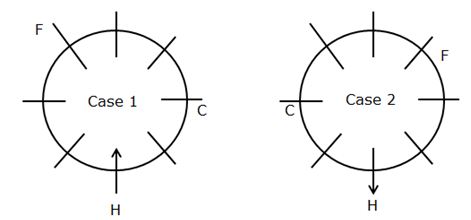
D sits fourth to the right of G and both are facing opposite direction.
G is not an immediate neighbour of H.
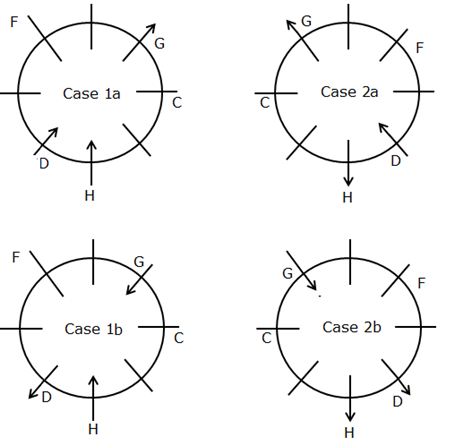
A sits second to the left of B, who does not sit opposite to H.
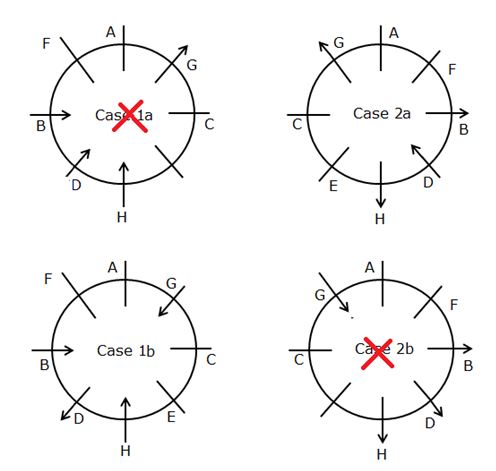
In case 1a and Case 2b, Not more than two persons are facing same direction sit together, this condition is not satisfied for the above two cases so these cases are rejected.
Immediate neighbors of H are facing opposite direction.
F and G are facing same direction.
A does not face inside.

If F and G are facing outside the centre then A should be facing towards the centre in case 2a. But A does not face inside is given in a statement, so this case is rejected.
And the Final solution is Case 1b.
1) Answer: c)
2) Answer: d)
3) Answer: c)
4) Answer: a)
5) Answer: c)
Direction (6-10):
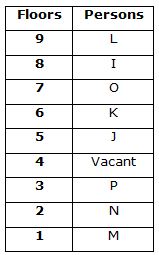
I lives second position from the top.
One of the even numbered floor is vacant
P lives third position from the bottom.
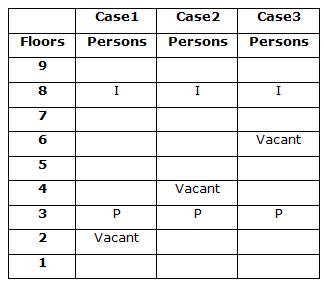
Only two persons live between M and J and both are live in odd numbered floor.
K lives an immediately above J.
J lives one of the floors above the vacant floor.
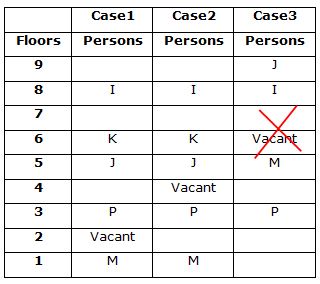
In case 3,K lives an immediately above J, this condition is not satisfied so rejected.
L lives three floors above from K.
N lives an even numbered floor but not the floor number 4.
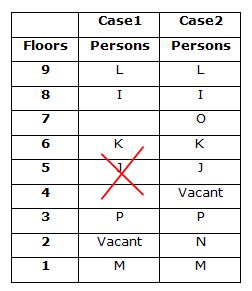
In case 1,N lives an even numbered floor but not the floor number 4,this condition is not satisfied so case 1 is rejected.
And the final solution is case 2.
6) Answer: c)
7) Answer: b)
8) Answer: b)
9) Answer: c)
10) Answer: e)
Direction (11-15):
Words: Numbers of vowels in the word is increasing order from the left end. If the word having same number of vowels then it is written in alphabetical order.
Numbers: Sum of digits with in the number and it is written in ascending order from the right end for each step.
Input: 48 Account 54 62 fixed output starts 43 29 grown
Step I: grown 48 Account 54 62 fixed output starts 29 43
Step II: grown starts 48 Account 54 fixed output 29 4362
Step III: grown starts fixed 48 Account output 29 436254
Step IV: grown starts fixed Account 48 output 43625429
Step V: grown starts fixed Account output 4362542948
11) Answer: e)
12) Answer: b)
13) Answer: a)
14) Answer: c)
15) Answer: a)
Direction (16-17):
16) Answer: d)
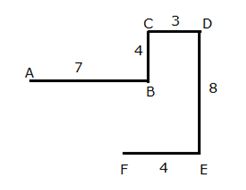
17) Answer: b)
=√ (16+ 36)
=√52
=2√13
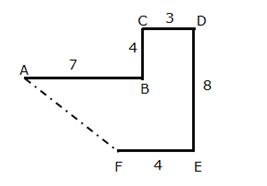
Direction (18-19):
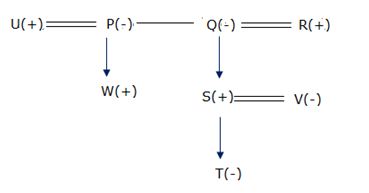
18) Answer: d)
19) Answer: c)
20) Answer: d)

Direction (21-25):
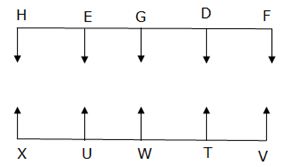
T sits third to the right X.
F faces theperson who is an immediate neighbour of T.

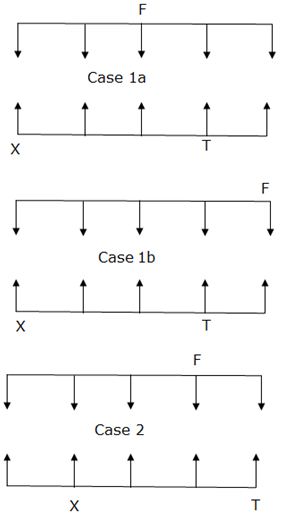
Only two persons sit between F and E.
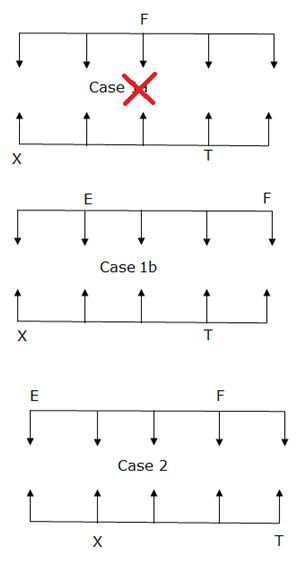
In case 1a, only two persons sit between F and E, this condition is not satisfied so this case is rejected.
None of the persons sit together in alphabetical order.so easily fix the position of the remaining persons
We can fix the position of D and U in case 1b and also G and W in case 2.
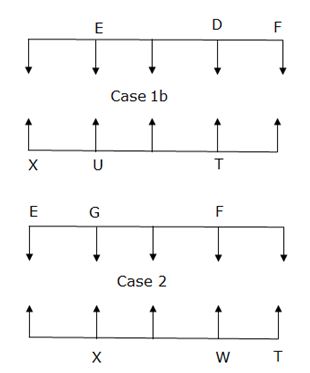
H faces the one who sits immediate left of U.

In case 2, H faces the one who sits immediate left of U, this condition is not satisfied so this case is rejected.
And the final solution is case 1b.
21) Answer: c)
22) Answer: d)
23) Answer: a)
24) Answer: c)
25) Answer: e)
Direction (26-30):

V attends the seminar on one of the days after Thursday.
The youngest person attends the seminar on Tuesday.
Only two persons attend the seminar between V and Q, whose age is 34.

P attends immediately after U, whose age is 38 but not Tuesday.
Only one person attends the seminar between Q and T.

R attends the seminar before S, whose age is 28.
T is older than P and younger than V.

In case 2, T is older than P and younger than V, this condition is not satisfied so this case is rejected.
26) Answer: d)
27) Answer: a)
28) Answer: d)
29) Answer: c)
30) Answer: d)
Directions (31-34):
31) Answer: a)
A ≥ C > D, E < F = C
I. A >E (A ≥ C = F>E) –> True
II. E < D (E < F = C > D) –> False
32) Answer: b)
R< S≤ U, W=U>V
I. R<V (R< S≤ U >V ) –> False
II. U>R (R< S≤ U=W) —> True
33) Answer: c)
J≤K=L, L≥M>N
I. J≤N (J ≤ K=L ≥M>N) –> (CAN BE TRUE)
II. N<J (J ≤ K=L ≥M>N) –> (CAN BE TRUE)
34) Answer: d)
P>Q≥R, R=S<T
I. P <S (P>Q≥ R=S) –> False
II. Q>T (Q≥ R=S < T) –> False
35) Answer: e)
